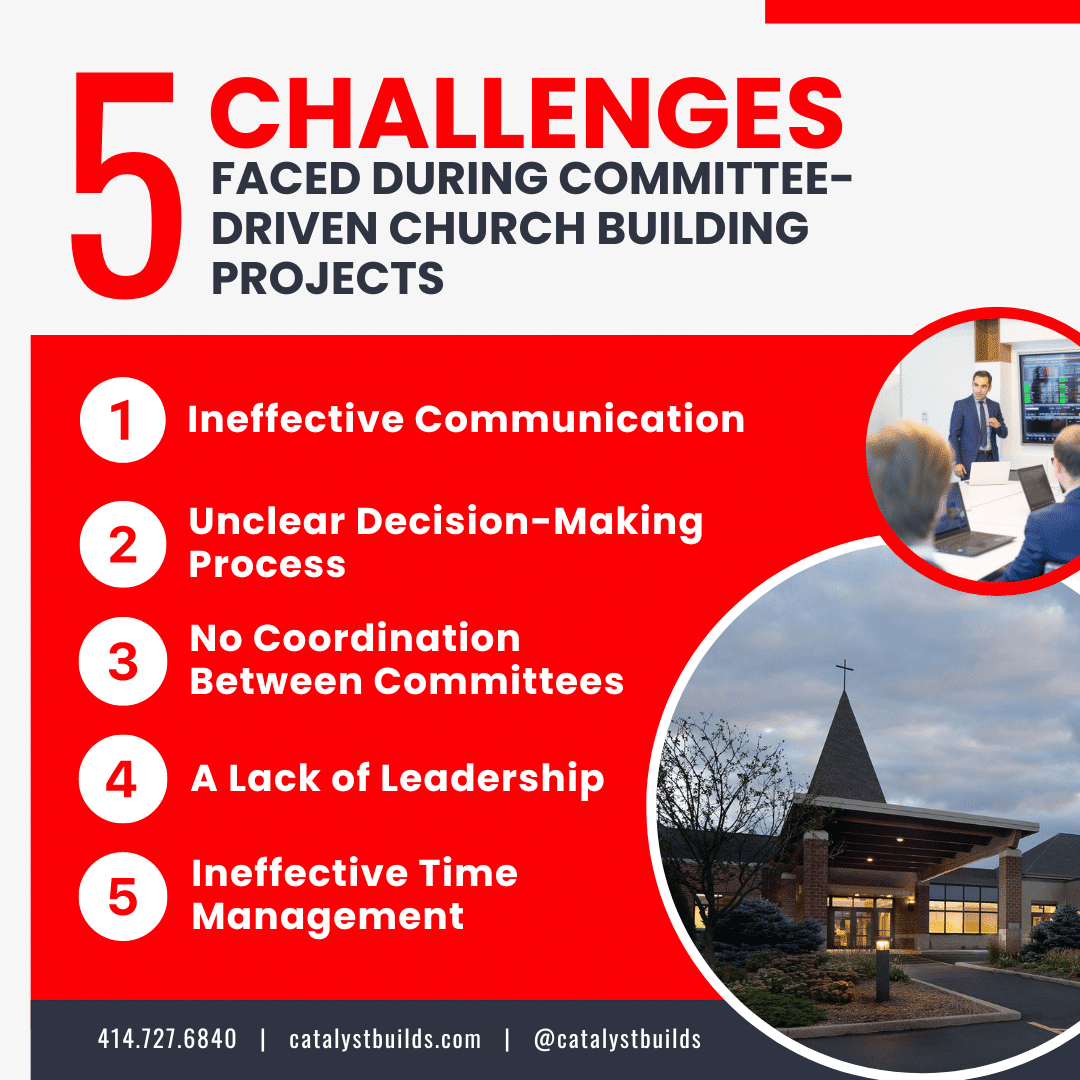“If you want to go fast, go alone. If you want to go far, go together.”
This ancient wisdom from Africa rings true across the centuries and across the ocean. Sometimes, efficiency isn’t what’s needed. Community is.
After all, the first – and only – thing God said that was not good in His creation was man being alone. We were designed to engage in life together.
That’s why the team at Catalyst Construction believes that church buildings are best constructed when churches adopt a team-based approach to their projects.
However, committee-led church building projects are not without their challenges. It is crucial to recognize and address these obstacles early in the process to ensure a smooth and successful journey toward the realization of your new space.
Some churches can deploy staff to lead specific teams, like AV or Tech. Other churches must rely on volunteer-led teams or a mix of staff and volunteers.
Renovating or constructing a church symbolizes collective faith, uniting purposefully and creating a physical space reflecting the vision for the future.
For a church that does not have the staff to drive the teams, volunteer-led committees play a vital role in this process, harnessing the passion and talents of the community to bring the project to fruition.
When building or renovating a space, unity, and determination are crucial for overcoming obstacles and turning your vision into reality as part of a congregation.
Join us as we venture on this enlightening exploration, uncovering the challenges inherent in committee-driven church construction projects and discovering the keys to unlocking your vision and constructing a space that will inspire and engage future generations.
5 Challenges Faced During Committee-Driven Church Building Projects
As your Church community comes together to engage the challenge ahead, it’s essential to be aware of the challenges that may arise along the way.
Below are five challenges that we’ve observed during committee-driven church building projects and solutions to minimize hidden surprises along the way:
1. Ineffective Communication
Communication is vital in committee-driven church building projects. Ensuring everyone is on the same page and working together is crucial.
When communication isn’t effective, it can cause problems like delays, confusion, and conflicts between committees.
The good news? There are simple strategies you can use to improve communication among committees.
First off, it’s essential to establish clear communication channels. This means deciding on the best ways to share information, like using email, messaging apps, video conferencing, and project management software, while keeping everyone connected and accountable.
Having these channels set up makes it easy for everyone to access and share important updates and documents.
Regular meetings and updates are also a great way to keep communication flowing. By getting together regularly, either in person or through video calls, committee members can discuss progress, address concerns, make decisions on action items, and share ideas when the need arises.
When done correctly, inter-committee meetings give team members a sense they are part of something bigger than themselves and develop their leadership skills.
If inter-committee meetings are not possible, then the committee chairs (or team leads) should communicate consistently and regularly.
By coming together on an effective schedule, committees can stay informed about the overall project status and promptly address any coordination issues.
2. Unclear Decision-Making Process
Making decisions can become complicated when multiple committees are involved in a project.
It’s essential to identify project goals and priorities. When you identify the goals so all committees are on the same page, the process of making decisions becomes simpler.
A grasp of a project’s overall scope and objectives is crucial in facilitating productive, timely decisions in the project’s best interest.
Each committee needs to realize they are a piece of the overall process. They have a role to serve and a specific “thing” they are responsible for. This is not a place for someone that always has to have a dissenting opinion or ulterior motive that takes the focus off course or is outside the boundaries they are responsible for.
However, there are strategies you can utilize to navigate this challenge and ensure a straightforward decision-making process.
Start with the right leader on each committee.
A humble, confident team leader is more important than an expert. You can have experts on the team, but the one in charge needs to be your church’s proven, humble leader.
The right leader will know how to bring the group to a consensus – or at least a decision – while ensuring everyone on the committee feels respected.
Committees need to know what they are responsible for and what they are not. Clear guidelines and deliverables are a must to keep everything on track.
Team unity is also essential, and that starts with everyone on the team feeling encouraged to participate in open dialog and bring ideas when ideas are needed.
Better solutions are often produced when a problem can be examined from multiple perspectives. One of a leader’s greatest responsibilities – and opportunities – is fostering a culture of collaboration and problem-solving when a problem arises.
Intentional, results-oriented, problem-solving discussions empower committees to work towards a common goal. Projects need to adhere to a timeline, and decisions need to be made in a timely fashion.
Finally, have a team designated as the lead team where the committee leaders report their findings and make their recommendations.
This team is responsible for making decisions within the boundaries the Church has approved.
Implementing a structured decision-making process is vital. Having a clear framework and guidelines helps everyone involved make decisions consistently and fairly.
It’s like having a roadmap that allows committees to evaluate options, consider different viewpoints, and eventually reach a consensus.
3. No Coordination Between Committees
Smooth coordination between committees is vital for the success of any committee-driven church building project.
Without proper coordination, tasks can overlap, important information can get lost, and the project can face unnecessary challenges.
Practical approaches can be implemented to enhance committee collaboration to ensure effective coordination.
First and foremost, clearly defining roles and responsibilities is essential when assembling the right church committee.
Having a central coordinator or project manager onboard significantly boosts coordination efforts. This role involves an administratively adept individual with an intricate understanding of project details and timing. Serving as vital support to the primary leader, they bridge committees, ensuring seamless communication and collaborative harmony.
They oversee the project, track progress, and proactively address coordination gaps. Their acute perception identifies operational inefficiencies, making them an indispensable asset in the lead team’s arsenal.
When everyone knows their specific duties and areas of focus, it becomes easier to avoid duplication of efforts and confusion.
Clearly outlining who is responsible for what helps streamline the workflow. It ensures that tasks are assigned to the right people so other committee members know who to turn to for what.
4. A Lack of Leadership
Leadership is crucial for successful committee-driven church building projects. Clear leadership structures are necessary to establish accountability and ensure progress.
To overcome challenges, identify leaders, define roles and hierarchy, and delegate decision-making. The best leaders are mature believers, have a solid reputation in their church, and are confident and humble in their leadership. They need to be able to lead.
Too often, I have seen churches place experts or high-level doers in the role of leader, and it rarely works out. A good leader will lead Doers and Experts to get the most done in a healthy, engaging, and productive way.
Leaders that can encourage collaboration and teamwork among team members foster a cohesive and productive environment. Strong leaders provide guidance, motivation, and direction, keeping the project on track and promoting cooperation. They know how to confront and correct without leaving someone emotionally injured in the wake. They are also an encourager. They understand the power of recognizing when someone does something well.
Defining roles and responsibilities helps individuals understand their contributions. Establishing a clear decision-making framework prevents conflicts and enables efficient progress.
Solid leaders harness diverse skills and perspectives, creating a positive example for committees.
5. Ineffective Time Management
Managing timelines and deadlines in church building projects involving multiple committees is crucial for effective time management.
To achieve this, it is essential to implement strategies for efficient time management.
One key strategy is developing a comprehensive project timeline. This involves breaking the project into specific tasks and assigning realistic deadlines for each. A well-defined timeline provides clarity and serves as a roadmap for the project, ensuring everyone understands the sequence of functions and their respective timeframes.
Regularly reviewing and adjusting deadlines is another important aspect of effective time management.
As the project progresses, evaluating the timeline and making necessary adjustments to accommodate any changes or unforeseen circumstances is essential. This flexibility allows for better adaptability and keeps the project on track.
Monitoring progress and providing support is also critical for effective time management. Regularly tracking each committee’s progress and identifying potential delays or bottlenecks helps maintain accountability and allows for timely intervention.
Offering support, resources, and assistance as needed ensures that committees can successfully overcome challenges and meet their deadlines.
Overcome Your Committee-Driven Church Building Challenges with Catalyst Ministry Solutions
When undertaking a committee-driven church building project, it’s essential to acknowledge and address the challenges that may arise along the way.
Effective communication, clear decision-making, smooth coordination, strong leadership, and efficient time management are crucial to success.
Catalyst Ministry Solutions is confident in our ability to recognize and overcome the unique obstacles faced by committee-driven churches.
With our dedicated support, we can help you successfully navigate these challenges and prevent any potential roadblocks from impeding your progress. Our “Readiness Audit” will uncover potential challenges on the road ahead and give you a clear timeline of achievable next steps and milestones.
Are you ready to take the next step in your journey? Let’s Talk! Contact us today!








